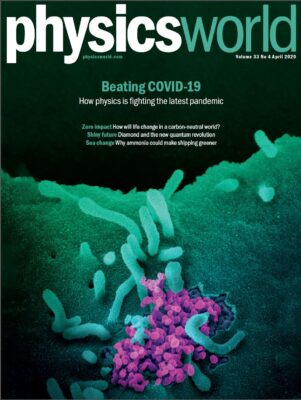The latest novel coronavirus, SARS-CoV-2, has reached pandemic status. While health workers and governments do their part, scientists are trying to understand the virus and develop vaccines and treatments. Jon Cartwright looks at how physics plays an important role in the fight

It probably originated in one of the several species of horseshoe bat found throughout east and south-east Asia. Possibly, a pig or another animal ate the bat’s droppings off a piece of fruit, before being sold at a wet market in Wuhan, China, and subsequently infecting one of the stallholders. Or maybe the first transmission to a human occurred elsewhere.
There is a lot we don’t know about the novel coronavirus now called SARS-CoV-2 and its resultant disease, COVID-19. What we do know is that Chinese authorities alerted the World Health Organization (WHO) to the first known cases in Wuhan at the end of last year. Less than a fortnight later, one of those infected people was dead. By the end of January, with more than 10,000 diagnosed cases and 200 fatalities in China alone, and with the virus cropping up far beyond the country’s borders, the WHO declared a global emergency.
As of this article’s publication (19 March), the WHO reports that the virus has spread to 166 countries, areas and territories, with over 205,000 confirmed cases worldwide and the number of deaths exceeding 8500. The status of “pandemic” was officially designated on 11 March and many countries have introduced social distancing, travel restrictions and quarantine methods to try to curb the spread. Festivals, sports events, parades and conferences are being called off due to the front-line support services they require and the concern that large gatherings of people could help spread the virus. The American Physical Society, for example, axed both its annual March meeting in Denver, Colorado, and April meeting in Washington DC.
When it comes to viruses, there is good reason to worry about novelty. Throughout its history, humanity has had to contend with new diseases springing up seemingly out of nowhere, spreading like wildfire and leaving scores of dead in their wake. In ages past, bacterial plagues were often the source of that terror. Since the birth of modern medicine, however, novel viruses have assumed the mantle of doom. Take Spanish flu for example, which killed up to 100 million people a century ago, and then more recently, HIV, which has led to around 32 million deaths to date. It is only a matter of time before another devastating pandemic, and though epidemiologists do not know what type of virus it will be, they do know that it will be different from anything witnessed before.
Whether or not SARS-CoV-2 is the next “big one”, there is something else epidemiologists are grimly aware of: today, disease travels fast. The Black Death that ravaged Europe, as well as parts of Asia and Africa, in the mid-14th century spread at an average of just 1.5 km a day – hardly surprising, since this was before ships could reliably cross oceans and the fastest mode of transport was by horse. Contrast that with the 2015 outbreak of Zika virus in South America, where the daily dispersion was on average 42 km, peaking in the densest-populated parts of Brazil at 634 km. Faced with more populous cities, more mobile people and more international travel, scientists must respond to the threat of viral pandemics faster than ever.
Fortunately, those scientists now have much more efficient tools at their disposal. Structural biology – the study of the structure and function of biological macromolecules – has come a long way since it was first used as the basis of rational (as opposed to trial-and-error) drug design 30 years ago. Back in the early 1990s, viral structures deposited in the Protein Data Bank – an international repository for structures of biological macromolecules – numbered just a few dozen annually, but by the mid-2010s, there were well over 500 new additions a year. Modern techniques, such as automation and cryo-electron microscopy (cryo-EM), mean that viral structures can be identified almost instantly in many cases. “Structural biology has reached the stage where it’s fast enough for almost anything,” says Alexander Wlodawer, chief of the macromolecular crystallography laboratory at the US National Cancer Institute in Frederick, Maryland. […]
The rest of this article is available here.